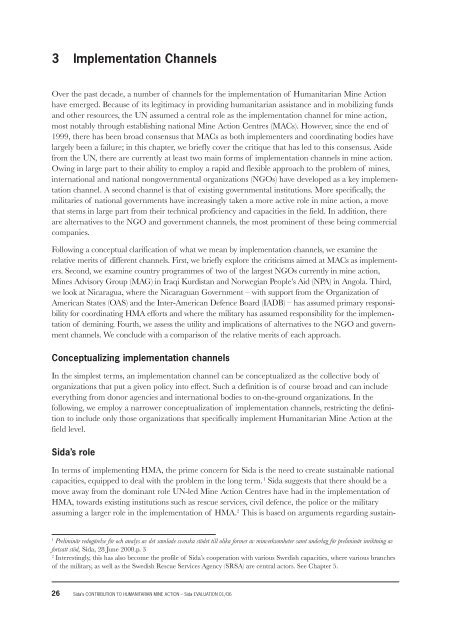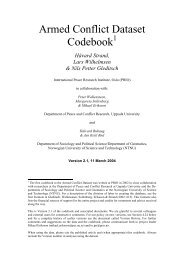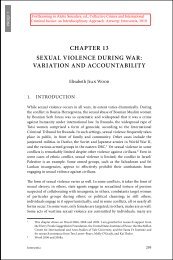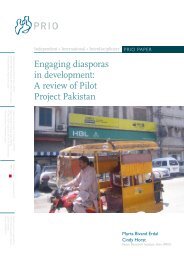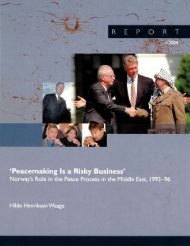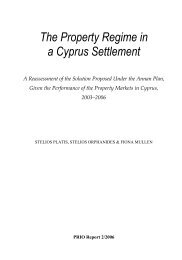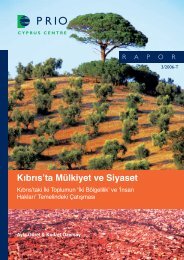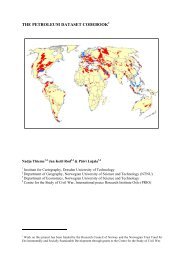3 Implementation ChannelsOver the past decade, a number of channels for the implementation of <strong>Humanitarian</strong> <strong>Mine</strong> <strong>Action</strong>have emerged. Because of its legitimacy in providing humanitarian assistance and in mobilizing fundsand other resources, the UN assumed a central role as the implementation channel for mine action,most notably through establishing national <strong>Mine</strong> <strong>Action</strong> Centres (MACs). However, since the end of1999, there has been broad consensus that MACs as both implementers and coordinating bodies havelargely been a failure; in this chapter, we briefly cover the critique that has led <strong>to</strong> this consensus. Asidefrom the UN, there are currently at least two main forms of implementation channels in mine action.Owing in large part <strong>to</strong> their ability <strong>to</strong> employ a rapid and flexible approach <strong>to</strong> the problem of mines,international and national nongovernmental organizations (NGOs) have developed as a key implementationchannel. A second channel is that of existing governmental institutions. More specifically, themilitaries of national governments have increasingly taken a more active role in mine action, a movethat stems in large part from their technical proficiency and capacities in the field. In addition, thereare alternatives <strong>to</strong> the NGO and government channels, the most prominent of these being commercialcompanies.Following a conceptual clarification of what we mean by implementation channels, we examine therelative merits of different channels. First, we briefly explore the criticisms aimed at MACs as implementers.Second, we examine country programmes of two of the largest NGOs currently in mine action,<strong>Mine</strong>s Advisory Group (MAG) in Iraqi Kurdistan and Norwegian People’s Aid (NPA) in Angola. Third,we look at Nicaragua, where the Nicaraguan Government – with support from the Organization ofAmerican States (OAS) and the Inter-American Defence Board (IADB) – has assumed primary responsibilityfor coordinating HMA efforts and where the military has assumed responsibility for the implementationof demining. Fourth, we assess the utility and implications of alternatives <strong>to</strong> the NGO and governmentchannels. We conclude with a comparison of the relative merits of each approach.Conceptualizing implementation channelsIn the simplest terms, an implementation channel can be conceptualized as the collective body oforganizations that put a given policy in<strong>to</strong> effect. Such a definition is of course broad and can includeeverything from donor agencies and international bodies <strong>to</strong> on-the-ground organizations. In thefollowing, we employ a narrower conceptualization of implementation channels, restricting the definition<strong>to</strong> include only those organizations that specifically implement <strong>Humanitarian</strong> <strong>Mine</strong> <strong>Action</strong> at thefield level.Sida’s roleIn terms of implementing HMA, the prime concern for Sida is the need <strong>to</strong> create sustainable nationalcapacities, equipped <strong>to</strong> deal with the problem in the long term. 1 Sida suggests that there should be amove away from the dominant role UN-led <strong>Mine</strong> <strong>Action</strong> Centres have had in the implementation ofHMA, <strong>to</strong>wards existing institutions such as rescue services, civil defence, the police or the militaryassuming a larger role in the implementation of HMA. 2 This is based on arguments regarding sustain-1Preliminär redogörelse för och analys av det samlade svenska stödet till olika former av minverksomheter samt underlag för preliminär inriktning avfortsatt stöd, Sida, 28 June 2000.p. 32Interestingly, this has also become the profile of Sida’s cooperation with various Swedish capacities, where various branchesof the military, as well as the Swedish Rescue Services Agency (SRSA) are central ac<strong>to</strong>rs. See Chapter 5.26 Sida’s CONTRIBUTION TO HUMANITARIAN MINE ACTION – Sida EVALUATION 01/06
ability; otherwise, Sida offers few suggestions as <strong>to</strong> the strengths and weaknesses associated with basingthe implementation of mine action on existing capacities. With regard <strong>to</strong> NGOs, Sida sums up itsexperiences as largely positive, with a particular emphasis on several key fac<strong>to</strong>rs. Chief amongst these isthe issue of transparency, the building of national and local knowledge, and concern for impact issues. 3The bulk of Sida’s support has been channelled via UN-led MACs and through NGOs. Roughly 50%of Sida’s overall support has gone through MACs, while 31% has gone directly <strong>to</strong> NGOs. 4 At the sametime, a note of caution is necessary: the bulk of Sida’s support <strong>to</strong> MACs is channelled <strong>to</strong> a variety ofimplementing organizations. Because Sida does not earmark its contributions, it is difficult <strong>to</strong> ascertainexactly how the funds were used. Sida’s current position is that its policy needs <strong>to</strong> be modified, in order<strong>to</strong> ensure that support is provided <strong>to</strong> organizations that are viable in the long term.The UN channelUntil the end of 1999, UN-established <strong>Mine</strong> <strong>Action</strong> Centres were mandated <strong>to</strong> act as both the coordina<strong>to</strong>rsand implementers of <strong>Humanitarian</strong> <strong>Mine</strong> <strong>Action</strong>. Following the findings and recommendationsof the influential 1997 UN Department of <strong>Humanitarian</strong> Affairs (DHA) reports, an internationalpolicy consensus has developed over the past few years, contending that these two functions should bekept separate. 5 According <strong>to</strong> this view, MACs are <strong>to</strong> function primarily as coordination bodies, with theauthority <strong>to</strong> subcontract independent agencies <strong>to</strong> implement HMA at the field level. Nevertheless, thestatus of the UN in relation <strong>to</strong> the implementation of mine action is somewhat ambiguous, and thedistinction between the role of MACs as implementers and coordina<strong>to</strong>rs remains blurred. In the recentcontroversies surrounding the Cambodian programme, the separation of implementation and overarchinggovernance functions has been a key issue. The Cambodian <strong>Mine</strong> <strong>Action</strong> Centre (CMAC) isformally run by the government, but with heavy input from the international community. Over thepast two years, following accusations of mismanagement and corruption, the programme has undergonemassive reforms, at the same time as many donors have withheld funds. In this context, it hasbeen pointed out that not only is it a problem that the implementing agency, CMAC, is not subject <strong>to</strong>sufficient external control, but also a further problem has been that the governing organ has engagedin detail administration. 6 With the establishment of the Cambodian <strong>Mine</strong> <strong>Action</strong> Authority (CMAA),this is meant <strong>to</strong> change. Apparently, the extent <strong>to</strong> which CMAA will take on coordination functionsremains <strong>to</strong> be fully clarified, but recent guidelines call for CMAC <strong>to</strong> assume responsibility. As formulatedin the most recent plans, CMAC will be responsible for both implementation and coordination forthe foreseeable future.A similar ambiguity characterizes the Afghan programme. In Afghanistan, the implementation ofmine action is largely carried out by so-called national NGOs. Meanwhile, the <strong>Mine</strong> <strong>Action</strong> Centre forAfghanistan (MACA) retains control over the programme’s coordination. However, these nationalNGOs were established by the UN in the early 1990s and continue <strong>to</strong> remain under the strict controlof MACA. The execution of projects is regulated by detailed project agreements, and MACA retainscontrol over funding. The end result is that national Afghan NGOs, who are proficient in both practi-3Preliminär redogörelse, p. 12, note 1 above.4The UN figure is Sida’s own estimate (Preliminär redogörelse, p. 12, note 1 above), the NGO figure is our calculation basedon Sida’s table on <strong>to</strong>tal contributions <strong>to</strong> HMA from the same document (see Appendix 1.3).5Robert Ea<strong>to</strong>n, Chris Horwood, & Norah Niland, 1997. Study Report: The Development of Indigenous <strong>Mine</strong> <strong>Action</strong> Capacities, NewYork: DHA.6John Mellors & Jan Rohaan, 2000. Independent Assessment of the Cambodia <strong>Mine</strong> <strong>Action</strong> Centre Structural Reform Program Final Report.Pnomh Penh, 15 June.; CMAC, 2001. Integrated Work Plan 2001, Pnomh Penh, 15 January. See also Dominique Pierre Guéret& Hul Thol, 2000. Socio-Economic Evaluation of the Cambodian <strong>Mine</strong> <strong>Action</strong> Centre, Pnomh Penh, 24 July.Sida’s CONTRIBUTION TO HUMANITARIAN MINE ACTION – Sida EVALUATION 01/06 27
- Page 4: This report is part of Sida Evaluat
- Page 9 and 10: MDDMEDDSMGMMLSWMoPHMOUMPLANATONDING
- Page 12 and 13: the conclusions of this report is t
- Page 14 and 15: A prime concern with Mine Action Ce
- Page 16 and 17: 3. The coordination of mine action,
- Page 18 and 19: an needs and the needs of victims o
- Page 20 and 21: At the same time as Sida has been o
- Page 22 and 23: er, throughout the data collection,
- Page 24 and 25: Donors may feel that the costs of i
- Page 26 and 27: is genuinely new. 8 At an overall l
- Page 28 and 29: The first attempt to apply a form o
- Page 30 and 31: standard for basic impact surveys.
- Page 32 and 33: Community studiesCommunity studies
- Page 34 and 35: and progress monitored in all phase
- Page 38 and 39: cal implementation and management,
- Page 40 and 41: ing that demining has any effect at
- Page 42 and 43: actual response. In an effort to ov
- Page 44 and 45: ecently developed. The approaches t
- Page 46 and 47: A different tool that will be used
- Page 48 and 49: Alternative implementation channels
- Page 50 and 51: appear to have been doing a good jo
- Page 52 and 53: Coordination may at times even be c
- Page 54 and 55: itarian and development effort. Imp
- Page 56 and 57: Two). In terms of coordinating mine
- Page 58 and 59: ased demining of AREA. Another type
- Page 60 and 61: The Kosovo UNMACC took a number of
- Page 62 and 63: would be accredited and tasked by U
- Page 64 and 65: programme. The proposal was backed
- Page 66 and 67: The present landscape of Swedish ac
- Page 68 and 69: demining purposes. Buoyed by a wave
- Page 70 and 71: given that SRSA also recruits perso
- Page 72 and 73: teams. The need for a breeding capa
- Page 74 and 75: 6 RecommendationsIn the preceding c
- Page 76 and 77: • MACs should operate with agreem
- Page 78 and 79: 7 ConclusionIn this report, we have
- Page 80: 70Appendix 1
- Page 89 and 90:
Ziauddin Operations Officer METADup
- Page 91 and 92:
Bennedich, Claes Department for eva
- Page 93 and 94:
Appendix 3BIBLIOGRAPHYAccelerated D
- Page 95 and 96:
Faulkner, F. & L Pettiford, 1998.
- Page 97 and 98:
McGrath, Rae, 2000. Landmines and U
- Page 99 and 100:
Miscellaneous DocumentsBrady, Justi
- Page 101 and 102:
Appendix 4Sida’s CONTRIBUTION TO
- Page 103 and 104:
Appendix 6• The area must be secu
- Page 105 and 106:
Appendix 7Locality identifier: Dist
- Page 107:
Recent Sida Evaluations00/37:1 Asse


